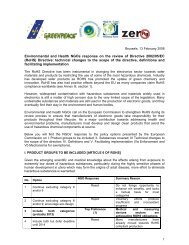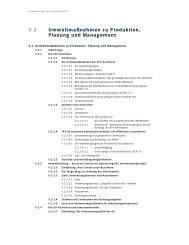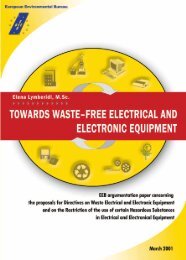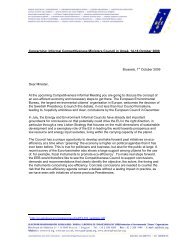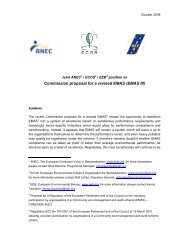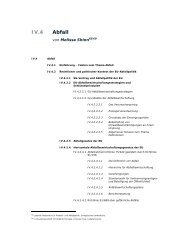Eu Mercury phase out in Measuring and Control Equipment - EEB
Eu Mercury phase out in Measuring and Control Equipment - EEB
Eu Mercury phase out in Measuring and Control Equipment - EEB
You also want an ePaper? Increase the reach of your titles
YUMPU automatically turns print PDFs into web optimized ePapers that Google loves.
REPORT FROM THE CONFERENCE “EU MERCURY PHASE OUT IN MEASURING AND CONTROL EQUIPMENT”• The view of several hospitals (which use mercury-free sphygmomanometers) is that it istechnically possible <strong>and</strong> economically feasible to undergo the transition.• The ma<strong>in</strong> constra<strong>in</strong>s to switch<strong>in</strong>g to alternatives is that mercury is considered the gold st<strong>and</strong>ard<strong>and</strong> most long term cl<strong>in</strong>ical studies are based on that. Other barriers <strong>in</strong>clude the familiarity ofhealthcare professionals with mercury sphygmomanometers <strong>and</strong> their need for the exist<strong>in</strong>gvalidation protocols.• Overall, sphygmomanometer comparative costs are very similar; therefore the purchase decisionshould be based on other important concerns such as toxic content <strong>and</strong> waste managementpractices rather than the <strong>in</strong>itial purchase cost.• There is still a debate on whether sphygmomanometers are still essential either for calibrationpurposes or for the treatment of special health conditions such as arrhythmia or pre-eclampsia.From one <strong>in</strong>dustry po<strong>in</strong>t of view, mercury sphygmomanometers are needed for these purposes.However, those who have undergone the transition stressed that the mercury-free alternativesare adequate for use.• Many countries around the world are already <strong>in</strong> the process of phas<strong>in</strong>g <strong>out</strong> the use of mercurydevices <strong>in</strong> healthcare. As one example, Swedish hospitals converted to mercury-free alternatives<strong>in</strong> the early 1990s. However, before the transition took place, these were <strong>in</strong> close contact withexperts, especially with the Swedish Society for Cl<strong>in</strong>ical Physiology to ensure that thealternatives functioned just as well.• In the USA, at least 10 States have banned mercury <strong>in</strong> measur<strong>in</strong>g devices <strong>in</strong>clud<strong>in</strong>g mercury <strong>in</strong>sphygmomanometers, with little or no opposition.• The Philipp<strong>in</strong>es had an adm<strong>in</strong>istrative order to <strong>phase</strong> <strong>out</strong> mercury from the healthcare sectoracross the country over two years <strong>in</strong>clud<strong>in</strong>g sphygmomanometers.• In Argent<strong>in</strong>a the M<strong>in</strong>istry of Health issued a Resolution (Feb. 2009) bann<strong>in</strong>g the purchase of allnew mercury thermometers <strong>and</strong> sphygmomanometers <strong>in</strong> the healthcare system. Examples of<strong>phase</strong> <strong>out</strong>s also exist at prov<strong>in</strong>cial <strong>and</strong> municipal levels.• Globally, world governments agreed that deliberations should start towards a global legallyb<strong>in</strong>d<strong>in</strong>g <strong>in</strong>strument <strong>in</strong> view of reduc<strong>in</strong>g mercury emissions, supply <strong>and</strong> dem<strong>and</strong> globally. As partof this effort, it’s envisioned that hospitals should beg<strong>in</strong> to <strong>phase</strong> <strong>out</strong> mercury <strong>and</strong> <strong>in</strong>creaseefforts to reduce <strong>and</strong> where possible elim<strong>in</strong>ate the amount of unnecessary mercury equipment.Technical matters• When it comes to mak<strong>in</strong>g an accurate read<strong>in</strong>g of any blood pressure device (whether mercury ormercury-free) of a patient it was generally agreed by conference participants that this isdependant on such factors as:o The skills of the measurer/operator/observer of apply<strong>in</strong>g the technique properly.o The quality of the product (whether it is validated or not, leak<strong>in</strong>g cuff, tube, bulb orvalve).o The patient (for example patient movement, patient position, stress, white coat effect,cuff siz<strong>in</strong>g, variability of blood pressure, etc.)o R<strong>out</strong><strong>in</strong>e ma<strong>in</strong>tenance <strong>and</strong> calibration is needed for both devices <strong>in</strong> order to function atpeak performance• Calibration was extensively discussed. In this context it means that any sphygmomanometer iscompared with a reference manometer to ensure that it measures accurately. Dur<strong>in</strong>g the process,the marg<strong>in</strong> of error of the reference manometer is added to the marg<strong>in</strong> of error of the mercurysphygmomanometer itself. Thus, there is a comb<strong>in</strong>ed potential error, which means that thereference manometer should be as accurate as possible. For example: a mercury column couldreplace the digital gauge, but the accuracy of that device is +/- 3mm Hg. The accuracy of theaneroid is +/- 3 mm Hg. If that is added together you can only test to +/- 6mm Hg, which is not6



